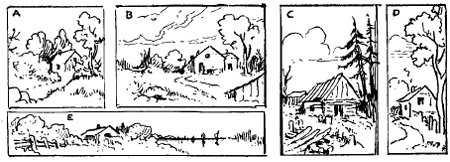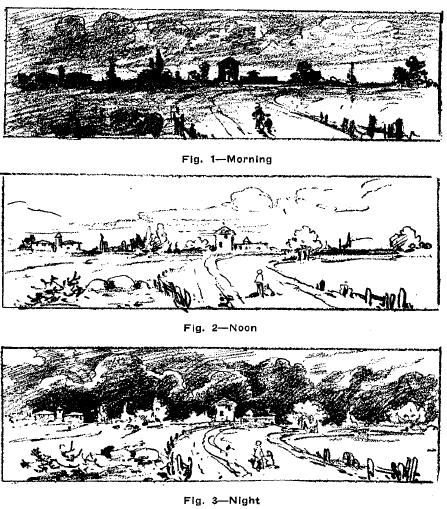Home > Directory of Drawing Lessons > Art Principles & Elements > Art Composition >Principles of Composition
PRINCIPLES OF COMPOSITION : Arranging Art Elements for Drawing Compositions
|
|
Principles of CompositionThe general arrangement of the characters and surroundings of a picture is implied in the word "composition." By a composition is meant an original grouping of the objects and the light-and-shade scheme comprising a picture. The simplest manner is generally the most harmonious and satisfactory. Things to Avoid in a composition are too many isolated groups and too many spots of light and shade. Few absolute rules can be laid down for composing a picture. All dresses are not alike. One's own good taste, one's sense of proportion, one's individual judgment must prevail. No inflexible standard of arrangement to guide us is found among the works of the painters of old or of modern times. Changing Component Parts.In composition of pictures, that which is seen in nature is frequently displaced or altered by means of addition, subtraction, multiplication, and transposition. By addition, we add objects that we do not see in nature, if such addition appears to add grace, symmetry or balance. For instance, we place a tree where no tree grew before, because another tree in the composition needs a companion to remedy its apparent loneliness, or to give that appearance of connectedness necessary to the general effect. Subtractionif something of nature obtrudes or we wish to erase it we subtract it from the picture. Multiplicationif we find only a single fence post, in order to get the necessary line that imagination demands, we stretch a dozen fence posts towards the horizon, diminishing them in size as they approach the vanishing point. TranspostionWe may transpose a mountain from one side to another in our picture as easily as we would a book from one shelf to another. This is true in sketching from nature, where adaptability and mobility are desired. It was Ruskin who said that it was the artist's privilege to move his objects around—be they mountains or pebbles—just as a chess player moves the figures on the chess board. The Shapes of Drawings.The square is the least pleasing shape for a drawing. One twice as long as it is high (or the reverse) is more pleasing. But the proportions of two and three, for a drawing, is the best average proportion. That is to say, one dimension should be two-thirds of the other. Thus: A is not, while B and C are well proportioned. D and E are The impression and effect on the beholder are the principal objects to be sought for.
Morning, Noon and Night.Figs. 1, 2 and 3 exemplify the manner in which nature's effects may be studied. The same scene is pictured, morning, noon and night. In the morning, when the light comes from the back of the objects in the distance, the latter is silhouetted against the rising sun. The shadows are thrown towards the sketcher, while in the noon aspect, the light "eats tip" the shadows, which are short and sharply defined. At night, the light is thrown directly towards the far distant parts, and they stand out in st g relief against the dark cloud-settings. There is no attenilbt at definition, or minuteness of detail in these sketches, the principles involved being merely indicated in a general way to assist the pupil with the artistic truths that must be absorbed by self-observation, rather than by the strict letter of written instruction. If the pupil can avail himself of the time and opportunity to make a sketch of some similar scene and study Nature's scheme of contrasts at the most distinctive periods of the day's divisions, it will be of great help to him. The spectator in the scenes depicted in Figs. 1, 2 and 3 is supposed to face the east. Fig. r is a morning scene and the sun is just rising. Fig. 2 shows the same scene at noon. Shadows now are barely perceptible. Fig. 3 is a sketch of the same place with the sun setting behind the sketcher.
Avoid Monotony.Living or inanimate objects that are intended to be the principal parts of a picture should not be overshadowed by their surroundings. Give the former more pronounced outlines and depth of shade or color, and use lighter, thinner lines and tones for the accessories-the fewer the better as a general thing. First Impressions.The pupil should be encouraged to develop his powers of composition and to make the best arrangement of all objects selected. All that he learns relating to blocking-in will help him, for the blocking-in habit is a good one and tends to looking at things artistic as a whole rather than piecemeal. Good composition relies greatly on the general aspect, the first impression that is made on the eye of the beholder. And by the blocking-in method a good first impression is more easily obtained. The mass is of more importance than the detail. A tendency to make very heavy lines at the outset will retard success in the blocking-in process. The pencil should be held long and loosely for blocking-in or when composing a picture. A shadow often determines the length and other dimensions of an object so forshortened or hidden that the eye has no apparent means of measurement.
|
Privacy Policy ...... Contact Us






